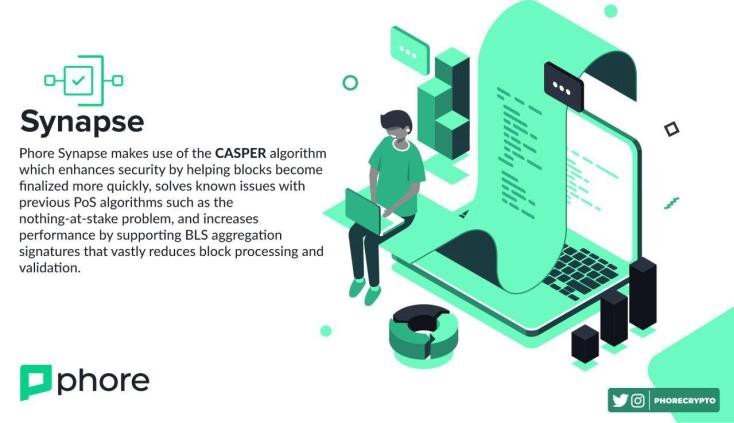The world’s most advanced & scalable blockchain architecture!
What is Synapse?
Phore Synapse is a revolutionary architecture which makes use of sharding technology and will have a theoretical capacity to process hundreds of thousands (100,000s) of transactions per second, support high-performance execution of fully Turing-complete smart contracts to support complex decentralized applications (dApps) and business models, and allow the creation of customized shards that are optimized for different use cases while allowing full interoperability between shards.
Unlike other proposed sharding platforms, the architecture being developed by Phore will retain a FULLY decentralized nature, as Synapse features a completely decentralized governance system, (though with extended capabilities), allowing much broader participation from the community as Synapse nodes will have much lower collateral requirements than current Phore Masternodes. These nodes will also take on the staking functions, which is not currently possible with traditional Masternodes. Phore Synapse will allow Synapse node owners to run their nodes whilst storing holdings offline or in cold storage, such as when protected within hardware wallets.
Unlike Phore’s current architecture which uses the Proof of Stake (PoS) 3.0 consensus algorithm, Phore Synapse makes use of the CASPER algorithm which enhances security by helping blocks become finalized more quickly, and reducing blockchain forks. This solves known issues with previous PoS algorithms such as the nothing-at-stake problem and increases performance by supporting BLS aggregation signatures that vastly reduce block processing and validation.
Synapse has been developed using the modern programming language ‘Go’ (Golang), and has had significant interest from other projects, including from the core team working on Ethereum — so much so that the Ethereum 2.0 (Go wallet) team has actually been using some of Phore’s code.
When the team who is leading development for a $25Billion Marketcap project is using our code, we know we’re doing something right!
Now, let us dive into a few potential use cases for the new Synapse architecture…
Potential Use Cases
Though it is commonly thought that the main ‘selling point’ of Synapse is focused around scalability, this technology actually opens the door to a vast array of new opportunities that extend far beyond financial transactions.
Decentralized applications (commonly referred to as dApps) are simply programs that are built upon a decentralized back-end. In the blockchain world, the decentralized back-end is the blockchain itself, and processing is handled by thousands of decentralized nodes. Many dApp platforms exist already, such as Ethereum and Tron, but high gas costs and slow block confirmation times limit their potential. Since Synapse will feature never-before-seen throughputs, its support for decentralized applications will be far smoother and provide a much better user experience. Imagine not having to wait five minutes for your wallet to confirm every transaction and save to the blockchain. Imagine not having ridiculous ‘gas’ fees with each transaction. Synapse helps to solve this without making significant compromises to decentralization or security.
Synapse also provides a solution to one of the traditional limitations of any blockchain protocol — optimization for a specific use case. Typically, a blockchain has to give up certain characteristics in favor of other ones — for example, if a blockchain is designed to store large amounts of data, it might need very large block sizes and slower confirmation times. Others might increase throughput and confirmation times by centralizing block mining and confirmation to a small set of nodes, compromising decentralization and security in the process. Synapse sharding has been designed to allow different types of blockchains to coexist within the same blockchain platform, and interoperate with each other. This means one shard type can be created for storing large data, and another type can handle fast transactions. In the future, we might add other shard types for private transactions, or decentralized storage, or a myriad of other use cases. Each shard type can be optimized for its specific use case and Synapse users can choose which shard to use at any given time, or even use multiple shards in parallel for complex smart contract applications.
Synapse will be a lightweight, ultra-fast, and low-cost infrastructure for dApps. The possibilities for use-case are endless, but let’s explore a couple of important ones.
dApps in the Healthcare Industry
The Healthcare industry currently faces many issues surrounding sharing medical information, treatment history, and medicine distribution. Blockchain technology has the potential to radically reshape the way that these data are stored and appropriated. Another common issue is the theft of health data from medical records, as these are currently stored in centralized locations that are prone to hacks. This hacked data is often sold or held for ransom.
Blockchains specialize in data, and healthcare is certainly a data-rich industry. It’s easy to conceive of a dApp centered around the storage of health-related data. Healthcare dispensers in various treatment networks would be able to log on to the decentralized data network to view patient history, which would lead to an improved standard of care regardless of where a patient goes to seek treatment (i.e. if they are visiting a different hospital).
Public health issues such as the current coronavirus pandemic also pose another opportunity for health-related dApps. If a dApp shares information between various health organizations, it could aid in faster development of treatments in the event of an epidemic, as health providers can enter treatment information into a single (decentralized) program to compare results.
DeFi Applications
Decentralized Finance — DeFi for short — is perhaps one of the most widely-used implementations of decentralized applications. In fact, the rise of DeFi is what some consider to be the most promising aspect of cryptocurrency. The movement to “unbank” yourself, and to become your own bank, is perhaps what led to the birth of Bitcoin back in 2009. Decentralized Finance is a very competitive space, with unicorn companies like Compound and Maker DAO leading the pack. Synapse’s extremely fast network and low fees would certainly provide a much needed competitive edge in this space.
Logistics & Transportation

The transportation industry faces a multitude of challenges and inefficiencies that could be mitigated by blockchain technology. Nearly all of these issues relate to procedures and payments, which frequently experience delays — a number of which are caused by payment disputes. Since blockchain payments are permanent, infungible, and peer-to-peer, the already existent use-case of cryptocurrency as a method of payment could solve these types of problems. It’s also important to note that the transportation industry processes a vast array of documents. An estimated 20% of the cost of transportation is administrative in nature, or related to paper costs. A blockchain-based, paperless method of meeting these administrative needs could cut costs for businesses and consumers alike.
As you can see from the few examples above, there is a huge global demand for a solution like Phore Synapse!
A look at Synapse Technology
Synapse is comprised of a few critical components: The beacon module, validator modules, shard modules, and relayer modules.
The Beacon Chain is what handles all of the proof-of-stake and validator registration transactions, and acts as the “main” network chain that links all of the Synapse shards together as one secure, integrated blockchain ecosystem.
Validator Modules interact with the beacon module. These modules are what produce the blocks for the beacon chain, and handle the user part of proof-of-stake functions. Validators commit to providing specific services to the Synapse network. There is a system of validator payment rewards and penalties that make up a core part of the enhanced security of the Synapse network, and provide a way for every Synapse user to actively participate in securing the Synapse network, and validators receive payments in return for staking and related services. They also run separately from the Synapse wallet, which will allow us to support secure, decentralized “cold staking” and even staking for balances held in mobile and other light node Synapse wallets.
The Shard Module acts as the “executor” for all of the side-chains. It executes the code for the side-chains and keeps them in sync with the beacon chain (see above).
The Relayer Module is the data management portion of the system, and keeps track of the entire state of each shard. “Relayers” then package up transactions to be submitted to the network, and advertise these packages to validators. Validators can then ensure that the packages validate without needing to keep track of the entire history of the shard. This module allows validators to execute transactions without syncing the entire state, which allows for both enhanced security a much better user experience because even full node user wallets will not need to download and validate a copy of the entire blockchain history — syncing wallet balances and transactions will be orders of magnitude faster.
A cross-link is a form of checkpoint that occurs in blocks when there is enough consensus across the Synapse network to finalize the block. Cross-links are used to finalize transactions that involve more than one shard, so they are used when moving balances from an address on one shard to an address on another shard.
All of these components working together create the world’s most advanced & scalable blockchain architecture!
Keep your eyes peeled for a brand new Synapse Development Update coming soon!
Source:
https://bit.ly/2ZIX3sG
Phore Crypo


Very nice info, Bit technical to understand but new projects like Phore are definite need to crypto community
I am definetly bulish on Phore Synapse